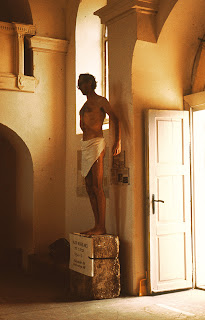An Exhibition by a CEU Alumnus
[This article was originally published in The CEU Weekly, Issue 32, April 10, 2013. http://ceuweekly.blogspot.hu/2013/04/an-exhibition-by-ceu-alumnus-leading.html)]
On the
occasion of The CEU Weekly’s anniversary, I would like to introduce something
that the CEU community can be proud of. The curator of a very interesting
current exhibition of the city “Leading
the Dead” – The World of János Major” is
a CEU alumnus, Daniel Véri. He is an art historian, currently a PHD candidate,
and graduated as a master of arts at CEU’s History Department in 2010.
János Major (1934–2008), graphic and conceptual artist,
was a major figure of the Hungarian neo-avant-garde and a member of the
so-called IPARTERV generation that emerged in the sixties. This exhibition is
dedicated to one characteristic segment of his oeuvre: works connected to death
and demise; the world of tombs and cemeteries. Major’s works presented in the
exhibition are organized along the lines of those specific traumatic events
that influenced the artist’s oeuvre deeply: the Holocaust (Major’s father
belonged to the victims), the revolution of 1956 during which the young artist
was touched and artistically inspired by the vision of hanged men on the
streets of Budapest. And a third trauma that gave inspiration to a series of
Major’s work during his life (although he
did not witness it), the Tiszaeszlár blood libel of 1882, a major encounter for
assimilationist Hungarian Jewry with Anti-Semitism. Thus, Major’s art builds
upon specifically East-Central-European, Hungarian and Jewish experiences.
 |
| Photo: János Major: Living Tomb Sculpture, 1973; György Galántai’s photograph taken at his chapel studio in Balatonboglár – Artpool Art Research Center |
Besides being a neo-avant-garde artist, Major was
interested in documentation and also worked in projects dedicated to
safeguarding medieval statues found in
Buda in the early seventies (his drawings based on the remnants help the
visitors to imagine the original state of the statues). He took plenty of
photos in the Jewish cemeteries of Hungary, some of which are presented in the
exhibition. They do not provide a simple documentation of the past, but – given
their titles – sometimes an ironic interpretation as well.
Nevertheless the value of János Major’s art, and of the
current exhibition, lies not merely in its artistic virtue, but in the fact
that individuals like Major help us to understand Eastern Europe’s history
during Socialism – especially the history of the sixties and seventies – better
and more deeply.
Agnes Kelemen, Nationalism Studies,
Hungary
With the
contribution of Daniel Véri, alumnus, History Department
The Exhibition is Open until 13 April 2013, at The
Hungarian University of Fine Arts, Barcsay Hall,
1062 Budapest, Andrássy street 69–71.

Megjegyzések
Megjegyzés küldése